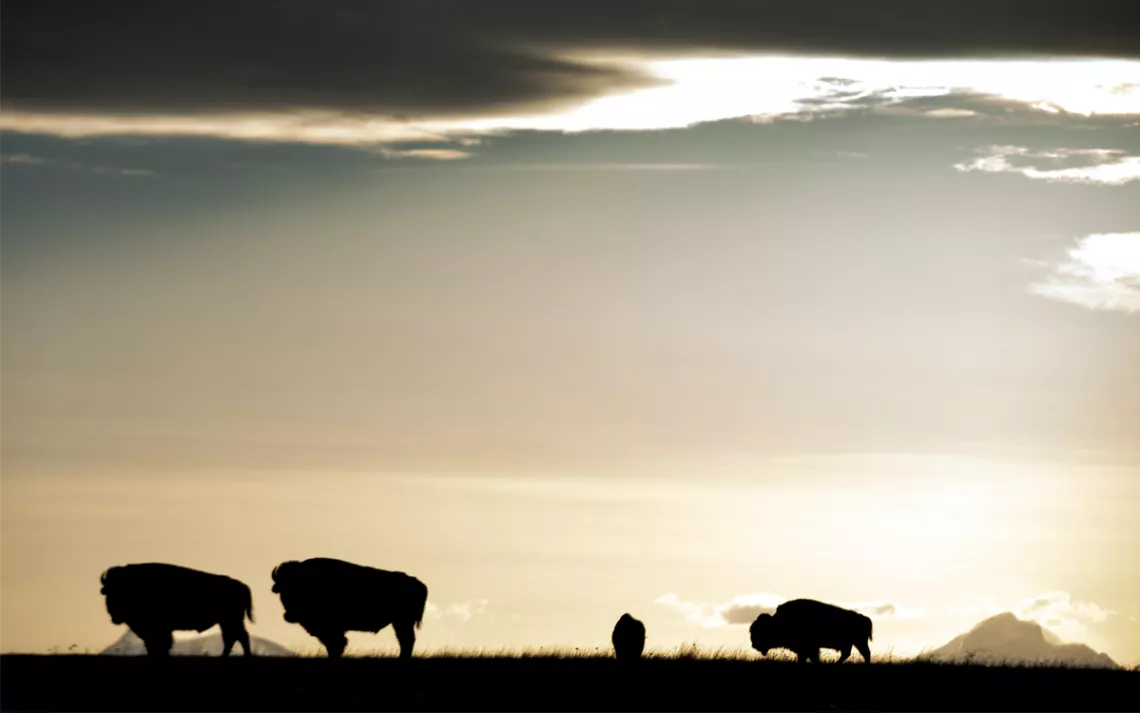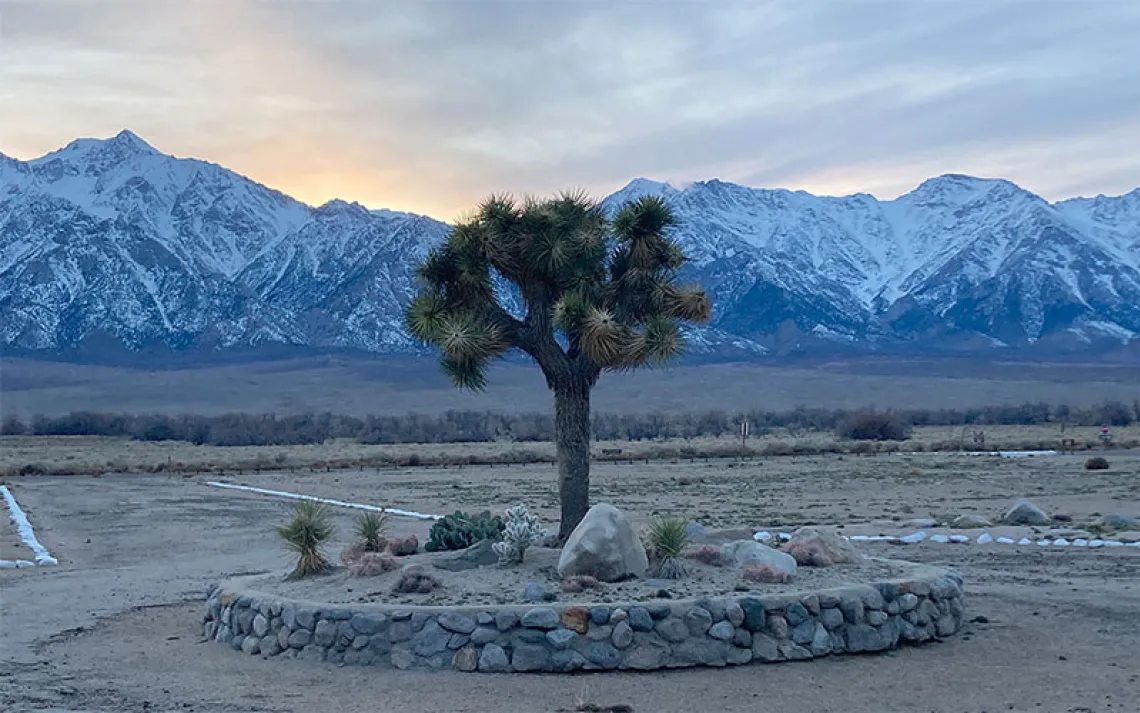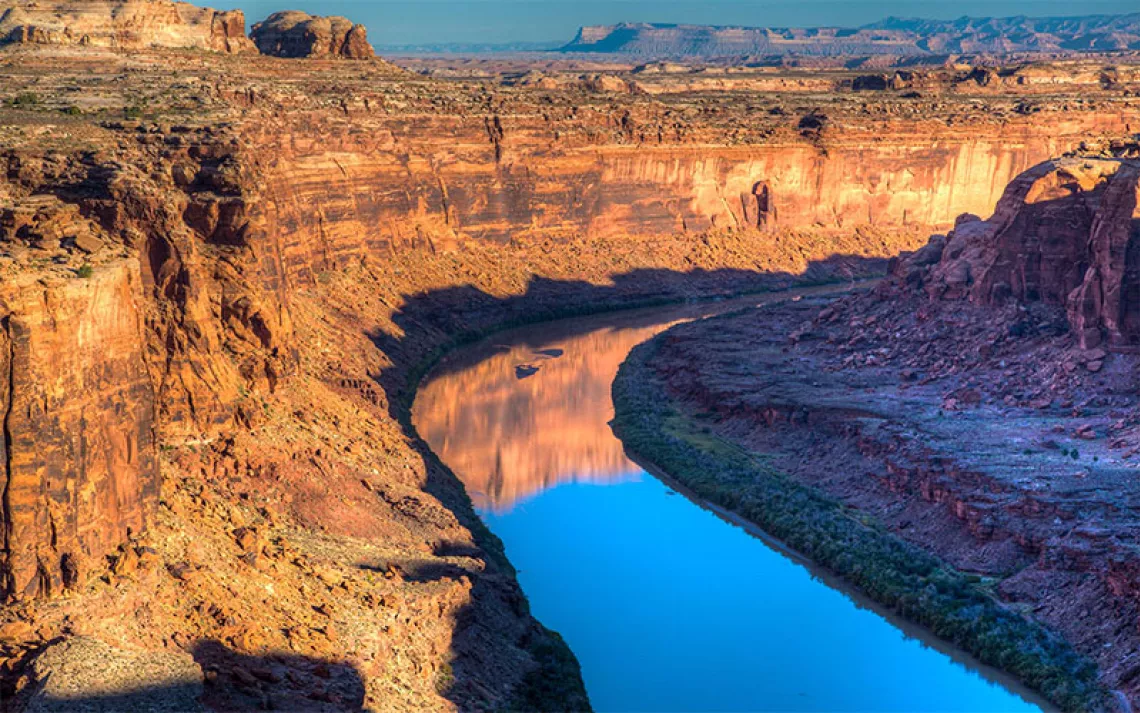The Bison and the Blackfeet
Indigenous nations are spearheading a movement to restore buffalo to the American landscape

THE ROLLING HILLS of the Blackfeet reservation were covered with bright-yellow balsamroot flowers, and in the distance the ridgeline of the Rocky Mountains was frosted with thinning snow. It was early June, and in Browning, Montana, the reservation's largest town, clouds of dust rose from the unpaved back streets. In the gas stations and cafes, talk dwelled on the past winter: who ran out of propane, who lost the most cattle, who was in the worst fix.
On the grassy banks of Two Medicine River, though, the bison were doing fine. The Blackfeet Nation manages about 800 animals, and several dozen bison were gathered in and around a large, sunny paddock. Calves stood knock-kneed next to their mothers, their short, golden-brown hair contrasting with the adults' heavy, half-shed winter coats. Ervin Carlson, manager of the Blackfeet Nation's Buffalo Restoration Project, got out of his pickup truck and approached. As I followed, the animals snorted warily. One calf lifted a tail and peed abundantly, out of fear or defiance or both. I recalled a comment by Blackfeet elder Charlie Crow Chief: "They recognize a stranger."

Ervin Carlson, manager of the Blackfeet Nation's bison program. "The buffalo are here today, and so are we."
Carlson chuckled, surveying the bison proudly. "The way I look at this herd is that they were in storage," he said. "They put themselves in storage until they were ready and we were ready." The ancestors of these bison were among the last remaining in Blackfeet territory in the early 1900s, members of a herd that was purchased from a private owner by the Canadian government. More than a century later, in spring 2016, 88 young descendants of that herd were loaded into livestock trailers and transported from Elk Island National Park in northern Alberta to the land of their forebears, where their arrival was celebrated by a waiting crowd.
The Elk Island bison and their offspring are now left largely to themselves, and most people see them only from a distance. But their presence is felt all over the reservation and has inspired projects ranging from a bison-meat lunch program at the Blackfoot language immersion school to a reenactment of a buffalo hunt at the reservation high school. Students participate in the annual harvest of members of a herd designated for local use, occasionally spattering themselves with blood as they learn how to butcher a bison.
The indiscriminate slaughter and last-minute rescue of the American bison at the turn of the last century is one of the best-known chapters in conservation history. What's not as well known is that the rescue was left unfinished. While the bison were saved from oblivion, they weren't returned to their former ecological and cultural roles on the prairie. The effort to complete that work and to fully restore bison to the North American plains continues today—and as its leaders reckon with the ironies and oversights of history, they're ushering conservation into the future.
THE BLACKFEET ARE one of four Blackfoot-speaking US tribes and Canadian First Nations—known collectively as the Blackfoot Confederacy—whose ancestors relied on the bison herds of the North American plains. They hunted bison by driving them over cliffs, now referred to as buffalo jumps, or by luring them into corrals and shooting them with bows and arrows. They cured bison hides for blankets, robes, and teepee covers; they boiled bison bones in hide-lined pits to extract the fat; they combined the fat with dried bison meat and berries to make pemmican, a protein-rich trail mix. Blackfeet historian Rosalyn LaPier writes that the thick hides of bison bulls were used to make rectangular food-storage boxes called parfleches; parfleches were packed with pemmican, which was preserved with peppermint and set aside for winter sustenance. Bison were so important to human survival that they became central to human culture, too, and are still celebrated in ceremonies.
During the centuries before European conquest, humans and bison shaped the plains—and each other. Bison numbers rose and fell as hunting strategies evolved, new technologies emerged, and economies changed, but the species never neared extinction. In fact, Native Americans' use of fire to clear forests and expand grasslands probably boosted bison numbers. Some historians believe that European settlers encountered the bison population at its peak.
In the early 1700s, North America was home to an estimated 20 million to 30 million bison, more than enough to circle the equator if laid nose to tail. The plains bison—a subspecies distinguished by the insistent scientific trinomial Bison bison bison—ranged from northern Mexico to southern Canada and from Oregon to the Appalachians. In fall 1770, George Washington and a few companions shot five bison in what is now West Virginia. In 1806, when explorers Meriwether Lewis and William Clark encountered a "moving multitude" of bison at the mouth of the White River in the Dakotas, the herd was so dense that it darkened the land. When mating season began in late summer, Lewis reported, the roaring of the bull bison could be heard for many miles, and "there are such numbers of them that there is one continual roar."

While the herd is mostly left to itself, the Blackfeet bison also provide meat to a lunch program at the Blackfoot language immersion school.
While even the deadliest buffalo jumps had little effect on these masses, guns and horses left a much deeper mark. The efficiency of equestrian hunting led Native American societies to depend even more heavily on bison, and by the late 1700s, their hunts had begun to take a toll on the herds. In the 1800s, when demand for buffalo robes and leather on the East Coast and in Europe prompted commercial hunters—first mostly Native American, then mostly white—to start killing bison wholesale in both the United States and Canada, the decline accelerated. After the first transcontinental railroad was completed in 1869, the decline turned into a free fall, with hide hunters slaughtering more than a million bison each year.
When the United States entered the final decades of its war on the plains tribes, the destruction of the bison began to look like a convenient way to control the enemy. Columbus Delano, President Ulysses S. Grant's secretary of the interior, believed that the disappearance of the bison would "confine the Indians to smaller areas and compel them to abandon their nomadic customs." In 1874, after Congress passed a bill restricting bison hunting, President Grant vetoed it.
Twelve years later, there were fewer than 300 free-roaming plains bison left in the entire United States. In Canada, there were thought to be none at all. In 1897, the last four plains bison living outside Yellowstone National Park were shot in a mountain valley in Colorado, and by 1902, despite efforts by the US military to control poaching in Yellowstone, the park's herd had been reduced to fewer than two dozen. Though some bison survived on ranches, and an isolated population of wood bison (the other subspecies of American bison) would later be discovered in northern Canada, the species that had traveled the continent for millennia was effectively extinct.
In the course of a few decades, the members of the Blackfoot Confederacy had lost their primary source of protein, warmth, and cultural strength. The reversal of fortune was cataclysmic, and its effects persist; the tribes and First Nations of the North American plains, once among the richest societies in the world, are today among the poorest.
THE SPECIES BIOLOGISTS call Bison bison is known in the Blackfoot language as iinnii, in Arapaho as bii or heneecee, and in any Indigenous plains language as a synonym for life itself. For most of the plains dwellers who experienced the species' near extermination, it was a crushing tragedy and a mortal threat. But on the urbanizing coasts of North America, in the centers of population and political power, the bison's demise was at first little more than a rumor—a tale from the very edges of the known world and the very limits of the imagination.
For many who heard about the bison slaughter from afar, extinction itself was a strange and relatively new idea. Though European explorers had already extinguished dozens of bird species on islands in the Atlantic, Pacific, and Indian Oceans, the long-standing assumption that species were static, enduring, and divinely created was not easily dislodged. Charles Darwin, in 1859, had acknowledged that humans could cause extinctions but maintained that extinct species would soon be replaced by others. While not all shared his equanimity, even some naturalists found it difficult to believe that humans could eliminate a species as plentiful as the American bison. For most people in the urban United States, bison were an abstraction, and the most common response to their reported plight was a shrug.
One of the few to take up the bison's cause was William Temple Hornaday, a brash young taxidermist at the National Museum—part of the Smithsonian Institution—in Washington, DC. Before Hornaday arrived at the museum in 1882, he had spent years traveling the world as a trophy hunter, killing elephants and tigers and selling their remains to museums for display, and he was surprised to discover that his new institution had only a few moth-eaten specimens of the mighty Bison bison. He wrote to contacts all over the Great Plains about the prospects for acquiring more, and from their replies he learned, with rising alarm, that there were few if any free-roaming bison left alive. "I awoke, dazed and stunned, to a sudden realization of the fact that the buffalo-hide hunters of the United States had practically finished their work," he later wrote.
Hornaday's paradoxical reaction to this realization was to shoot yet more bison. In 1886, he mounted two expeditions to Montana, determined to preserve at least a few of the remaining representatives of Bison bison behind glass. He and his companions spent several grueling weeks on the trail, riding past piles of bison bones and sunbaked flesh. They ultimately shot 20 animals, including a gigantic bull. Hornaday recalled that as he stood on the snowy prairie, pinned by the bull's dying glare, he experienced "the greatest reluctance I ever felt about taking the life of an animal."
Hornaday's bison display at the National Museum, which he revealed to the public in spring 1888, represented the species' predicament in new and memorable dimensions. For him, the obvious next step was to breed bison in captivity for release on the plains—or, as he put it, to "atone for the national disgrace that attaches to the heartless and senseless extermination of the species in the wild state."
In 1896, when Hornaday became the director of the zoological park that would become the Bronx Zoo, he started to pursue that dream in earnest. With the help of wealthy sportsmen—including soon-to-be-president Theodore Roosevelt—who considered bison essential to their own beloved pastime, Hornaday founded the American Bison Society, a private organization dedicated to the species' restoration. Society funding allowed him to begin breeding bison purchased from ranchers in Texas and Oklahoma, and after a few years of trial and error he established a small herd in the heart of the Bronx.
On October 11, 1907, at the Bronx Zoo, 15 city-raised bison were coaxed into wooden crates, then loaded onto railcars and transported nearly 2,000 miles to the Oklahoma Territory, where President Roosevelt had created the Wichita National Forest and Game Preserve in 1905. (The preserve's rich grasslands had been seized from the Apache, Comanche, and Kiowa.) When the bison reached the preserve, they were released into a pen to await the completion of a fence around their 8,000-acre enclosure.
The bison would not move with the seasons like their ancestors, but they would roam farther on the prairie than almost any bison had for decades. Their arrival was celebrated nationwide, and Hornaday, while not the only champion of the bison, was applauded as their species' savior. "Director Hornaday of the Bronx Zoological Park deserves the gratitude and encouragement of the Nation as the chief preserver from extinction of the American bison," The New York Times editorialized.
The Wichita herd flourished, and in 1908, Hornaday convinced Congress to designate another bison preserve, this time on 19,000 acres that the federal government had recently carved out of the Flathead reservation in northwestern Montana. By the time the American Bison Society stopped collecting dues in the mid-1930s, there were 20,000 bison in North America, most in large, enclosed reserves. They were nowhere near the "moving multitude" that once populated the plains, but they were numerous enough to ensure the persistence of the species for a good long while.
THOUGH HORNADAY RESCUED Bison bison from extinction, he didn't restore the species to its place on the landscape. Only in 1866 had zoologist Ernst Haeckel coined the word ecology, or oecologie, to describe the study of the relationships among organisms and between organisms and their environment. When Hornaday shipped bison from the Bronx to the Oklahoma grasslands, ecology had barely begun to develop into a formal discipline, and Hornaday was not an ecologist. He treated bison as livestock, letting them loose without much consideration of their role in the living network Darwin had described as the "entangled bank."
But, as future generations of scientists and conservationists would learn, bison had been part of the prairie in a very real sense, functioning as what ecologists call a keystone species. They had fertilized the soil with their dung, flattened saplings and shrubs with their hooves, and grazed so intensely in spring that the native grasses extended their growing season. In Yellowstone, bison still have more influence on the timing of plant growth than the weather does.
Over the past century, the expansion of industrial farming and the continued absence of large herds of free-roaming bison have shrunk the total extent of the North American tallgrass prairie from the size of Texas to little bigger than Delaware, turning it into one of the most endangered landscapes in the world. The northern shortgrass prairie, where Hornaday searched for bison, is similarly diminished.

Sign up to receive Sierra News & Views
Get articles like this one sent directly to your inbox weekly.
With this action you affirm you want to receive Sierra Club communications and may vote on policy designated by the Sierra Club Board.
The prairie that remains today is fundamentally different. As bison snuffle along the grasslands, microbes they take in through their noses and mouths help break down the cellulose in the grass they eat. Each of the resulting soft, wet piles of dung can support more than a hundred species of insects. When bison were plentiful, these insects fed a community of birds and small mammals, but many of those species are now seldom seen. Without bison, the prairie is a smaller and quieter place.
Hornaday and his allies also overlooked—and in many cases explicitly denigrated—the people who had depended on the bison. Hornaday insisted that Native Americans and white market hunters were equally responsible for the bison slaughter, despite contemporary evidence to the contrary. Along with the elite trophy hunters who supported him, he looked down on commercial and subsistence hunters, habitually blaming the worst effects of hunting on people of other races, ethnicities, and nationalities. Trophy hunting, meanwhile, was viewed by Roosevelt and other members of the American Bison Society as a tonic for white masculinity, which they believed to be threatened by immigration and urbanization. Their drive to save the bison, in other words, had less to do with the species than with their illusions about themselves. Protecting the American bison, to them, meant protecting a perniciously exclusive version of national progress.
Progress, however, often moves in unlooked-for directions, and the herds that Hornaday founded outlived his limited vision. In the 1990s, the Blackfeet Nation purchased its first bison, about a hundred of them, from the Hornaday reserves. Ervin Carlson, then head of the tribal agricultural department, oversaw the herd, and as it grew, he began to wonder whether truly free-roaming bison could be restored to the Northern Rockies. In 2008, he started to talk with Keith Aune, a biologist who had recently retired after a long career at Montana's state wildlife agency, about the possibility of returning more bison to the Blackfeet reservation.
Aune shared Carlson's interest in bison and was well aware of Hornaday's blind spots. A few years earlier, he had paid a visit to the Bronx Zoo—which also serves as the headquarters of the international Wildlife Conservation Society—and proposed reopening the doors of the American Bison Society. He hoped that the revived bison society, which was formally relaunched in 2005, would accomplish what Hornaday could not: reconnection of the plains bison with their landscape and, crucially, with the people who live on that landscape today.
Over the next several years, Aune secured funding and support for bison restoration on the Blackfeet reservation from the Wildlife Conservation Society. Meanwhile, members of the Blackfoot Confederacy founded a group called the Iinnii Initiative. Following the advice of Blackfoot Confederacy elders, the Iinnii Initiative helped negotiate an intergovernmental agreement called the Buffalo Treaty, which dedicates its signatories—now more than 30 tribes and First Nations in the United States and Canada—to the active pursuit of bison restoration and its ecological and cultural benefits. "The treaty really is about renewal and restoration and cooperation," says Blackfoot researcher Leroy Little Bear, one of the original organizers of the Iinnii Initiative. "It maps the future, seven generations ahead."
WHILE THE RETURN OF the Elk Island bison to the Blackfeet Nation in 2016 was heartily celebrated near and far, it didn't happen without controversy. Cattle ranchers, including some tribal members, worry that large bison herds—fenced in or not—will compete with them for grazing land and meat-market share.
Even among those opposed to bison restoration, however, there is a sense that bison are, as biologist Lee Jones puts it, "an important something." Important, that is, to history, culture, and the North American landscape. The Iinnii Initiative and the American Bison Society now serve as hubs within a diffuse, growing movement of tribes and First Nations, conservation groups, and state and federal agencies whose bison-restoration projects range from northern Mexico to the Arctic Circle.
On the Rosebud Sioux reservation in South Dakota this past October, a small group of masked, socially distanced supporters watched as 100 bison were released on the Wolakota Buffalo Range, a 28,000-acre stretch of native grassland. Under a far-reaching plan developed by the Rosebud Sioux and supported by conservation groups and federal agencies, the range's bison will one day number 1,500—the continent's largest tribally owned and managed bison herd. Wizipan Little Elk, director of the Rosebud Sioux economic development agency, predicts that the bison's benefits will range from cultural renewal to climate change mitigation. "They actually take care of us far, far more than we'll ever be able to take care of them, but we have to try to contribute to that reciprocal relationship," he says. "We're giving them an opportunity to be who they are, to do their work on the ground as a keystone species."
In February, less than four months after the Wolakota release, bison from the Elk Island National Park herd were welcomed by four Indigenous communities in Saskatchewan and Alberta—including the Kainai First Nation, part of the Blackfoot Confederacy, which released 40 bison on its reserve. Diandra Bruised Head, an environmental scientist, climate activist, and recently elected Kainai tribal councillor, says that while most of those present at the bison release were confined to their cars by the pandemic and the bitter cold, it was an emotional moment. "It hit me that I would be able to say that I was a leader for my tribe when the buffalo arrived," she says. As with other tribal herds, the bison's value to their caretakers is simultaneously enduring and immediate: Pandemic-induced food shortages, Bruised Head says, have made it painfully clear that her rural community needs a more reliable source of local meat.
While there are now an estimated half million bison on the North American plains, some 30,000 managed primarily for conservation rather than commercial sale, politics has kept the fences in place, and only a few bison are fully free-ranging. Carlson looks forward to a day when bison roam the prairie like elk and deer, and he may get to see it: If ongoing discussions between the tribe and the National Park Service proceed as expected, bison on the Blackfeet reservation will be permitted to move north at will, entering Glacier National Park and even crossing the international border with Canada. Making such connections is a priority of the federal Bison Conservation Initiative, launched in 2020, which commits all agencies within the Department of the Interior to supporting the continued restoration of bison to the North American prairie.
"The beautiful thing about bison conservation is that it's not a crisis," says Brendan Moynahan, a science adviser for the Park Service who is working closely with the Rosebud Sioux and other tribes on bison restoration. "Bison are super-resilient animals that reproduce well, so it isn't about saving the species—we've done that, and it's a great success story. But there is huge, huge opportunity on the ecological and cultural side of things."
Bison aren't as fundamental to human survival as they were when buffalo callers leaped off cliff edges. Then again, maybe they are. During a meeting in the Blackfeet Nation council chambers not long ago, bison project staff and visiting conservationists listened as elders spoke about the revival of the bison. Their generation was born decades after the Blackfeet lost their bison and came of age decades before the Elk Island herd returned, but their reverence for the species was clearly profound. Through tears, Betty Crow Chief said that her brother, while hospitalized after a severe heart attack, had seen images of bison move across the wall of his room. Many listeners nodded, unsurprised.
Perhaps the final irony of William Hornaday's irony-soaked life is that his blinkered foresight enabled an effort that strives to embrace so much—not only so much space and so many species, but also so many human cultures, values, and stories. When Hornaday rescued the bison from extinction, Carlson notes, he wasn't thinking about the Blackfeet, but the two are inextricable. "Back then, some people thought that if you killed the bison, you killed the Indian too," he says. "Well, the buffalo are here today, and so are we."
This article appeared in the Summer quarterly edition with the headline "The Long Road Home."
 The Magazine of The Sierra Club
The Magazine of The Sierra Club



